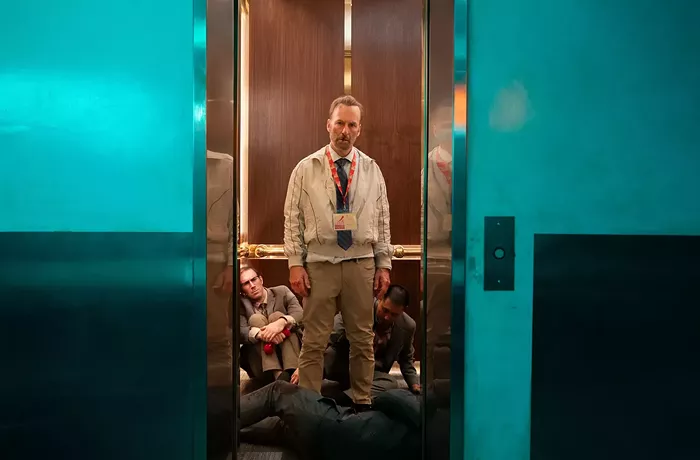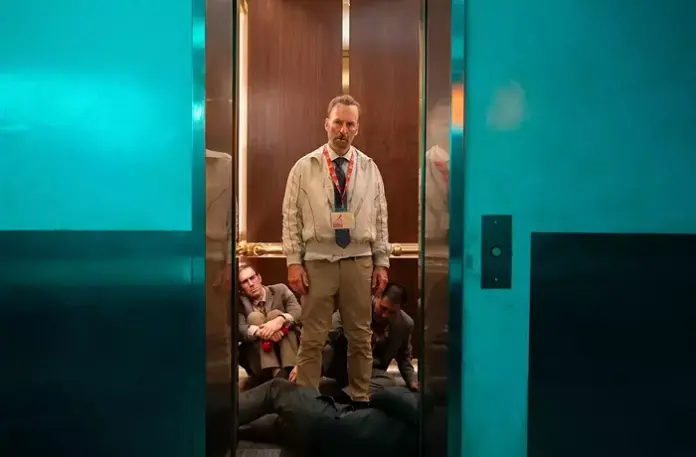This post was originally published on this site

There is a scene in Timo Tjahjanto’s The Big 4—his Netflix-backed 2022 action comedy/abattoir—that gives you all you need to know about the Indonesian filmmaker behind Nobody 2.
Amidst an endless array of carnage and climactic, intestinally-forthright fight choreography, the camera’s perspective follow a combatant’s face, as it’s stuffed into a toilet bowl.
But that’s not enough for Tjahjanto. The toilet must also brim with pieces of shit, and that character must also open his mouth to scream, inhaling all the shit water, in close-up.
But that’s still not enough. The aforementioned character’s face is wrenched from the bowl and immediately stabbed with a broken toothbrush, mixing incomprehensible fluids and unholy bacteria into the violent scene to fester under the skin.
It’s a blessed assault on our senses, and like that toilet, Netflix has become filled with Tjahjanto’s deeply affecting exploitation flicks. In brutal crime epics like 2018’s The Night Comes for Us, the director seems to have an intimate understanding of how bodies can move around a room, and then how every part of that room can be used to puncture those bodies apart.
While upsetting to many stomachs, the results of Tjahjanto’s on-screen indulgences can also be extremely satisfying displays of action cinema. His protagonists are typically brutal criminals who find redemption through Herculean feats of pain endurance and barely-won fights to the death. Tjahjanto’s melees come with clear emotional stakes; we wince hardest when we care about a character whose flesh not just splits, but ruptures, sizzles, curdles, and explodes.
Which is why the budding Nobody film series—Bob Odenkirk and Derek Kolstad’s entry into the canon of psychopathic family men committing atrocities dressed up as dad justice—is a good fit for Tjahjanto’s first go with a big Hollywood studio.
The original Nobody (2021), which followed archetypically wussy middle manager Hutch Mansell (Odenkirk) as he reveals to his family his secret past as a contract killer for the US government, dampened the pleasures of its violence with oppressive antihero tropes. The more Hutch demonstrated his penchant for delivering 300 Russian mobsters to death’s doorstep, the grimmer the film got, edging around the catharsis a good cinematic bloodbath can provide by making the whole affair feel, well, not very much fun.
Nobody 2, by contrast, revels in the cognitive dissonance of Hutch’s hyper-violence, and finds glee in it. He is a mass-murdering tool of the military industrial complex, but he is also a stalwart family man, which means we can root for him using his powers for good—or at least goodish—even if we know that violence will only beget violence. There will always be a worse bad guy behind the worst bad guy. Watch ‘em all die!
As the sequel begins, having burned the obshchak (a treasury of money shared by Russian oligarchs), Hutch has returned to carrying out “assignments” for the government, only this time he’s working to pay back all the money he destroyed. Because, you see: There are always more powerful forces at work than the main baddie from the first movie. So, back to killing as his 9-to-5 he goes, but after a particularly harrowing mission, Hutch requests a “break” from the institutionally sanctioned butchery to take his family on a little vacation.
Echoing Nobody’s opening montage, Hutch’s all-consuming job threatens to estrange his family. His solution is to “make memories” with them by going to Plummerville, a middle America destination for budget-friendly amusements, based on Hutch’s own fond childhood memories of eating hot dogs and riding duck boats. With his dad (Christopher Lloyd, wiry party grandpa) cramped in the back of the car between the kids, Hutch leads his family on an excursion that turns as quickly sideways as cinematographer Callan Green’s whip-tilting camera.
Inevitably, Hutch learns that there was an obvious reason his dad, a retired FBI agent, brought him to Plummerville so long ago. A prime trading hub for an incredibly lucrative criminal enterprise led by the evil-er-than-the-last-guy Lendina (Sharon Stone, clearly having a good time)—overseen on the ground by Sheriff Wyatt Martin (John Ortiz) and his fellow Sheriff, leering worm Abel (Colin Hanks)—Plummerville’s a wholesome town surreptitiously crammed with thugs, henchmen, and cronies.
You know where this is going: Hutch can’t help but cross Lendina’s operation, unable to just have a normal week off with loved ones. Meanwhile, several baseball teams worth of expendables fatally discover that Hutch is not some “random tourist,” all of it well-wrangled by a seasoned action director.
Odenkirk, who alternates ably between regular man and homicide god, appears energized by working with a new voice, one likely eager to get a solid budget and some recognizable stars. If only Tjahjanto seemed similarly jazzed.
For as much mayhem as the director can capture, Nobody 2 never pushes as far as we know Tjahjanto is capable of pushing. Too much happens off-screen. While many of the perspectives Tjahjanto finds to witness Hutch’s frequent brawls bear bloody fruit—a warehouse massacre is particularly fascinating seen from inside, through the sliding door, of the van where Sheriff Martin’s son (Lucius Hoyos) is helplessly bound—we know the director is capable of showing us so many more gratuitous sights.
I legitimately was hoping to see a man’s [redacted] maimed by a [redacted]. That is the catharsis I deserve. (And, what, we couldn’t afford a “Holiday Road” needle drop, Universal?)
Alas. Though guts are literally spilled and beautiful jawlines sliced into pieces of salami, practical stunts employed liberally, Tjahjanto drives this summer vehicle like he’s unchallenged by the course. Nobody 2 has glimpses of impeccably tuned filmmaking, but nothing as thrilling as everything Tjahjanto’s made before. That may not be enough, but it’s all we’re going to get.
Nobody 2 opens in wide release on Fri Aug 15, 89 minutes, rated R.
This review originally appeared in our sister publication, Portland Mercury.




















